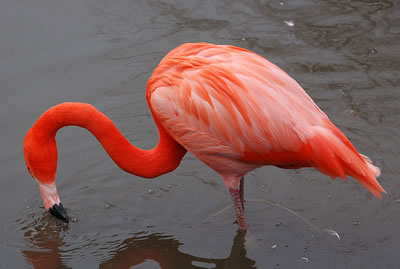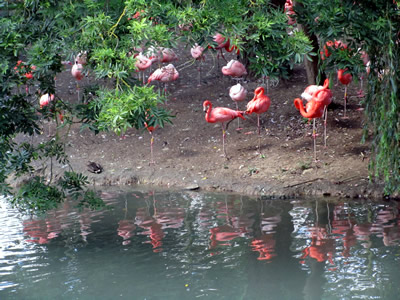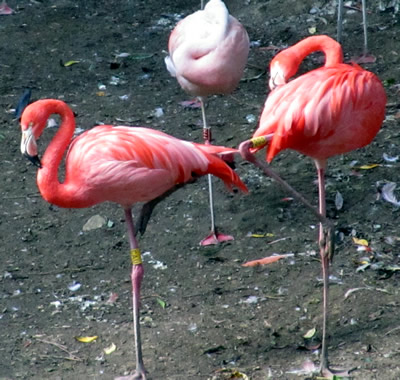Flamingo

Facts about creatures
- Home
- Animal Classification
- Animal Habitats
- Amphibians
- Arthropods
- Bats
- Birds
- Carnivorans
- Cetaceans
- Chordates
- Crustaceans
- Dinosaurs
- Diprotodonts
- Elephants
- Fish
- Golden Mole
- Insects
- Lagomorphs
- Mammals
- Mammal Teeth
- Marsupial Mole
- Metamorphosis
- Mollusks
- Primates
- Reptiles
- Rodents
- Ruminants
- Soricomorphans
- Tenrec
- Tetrapods
- Vertebrates
Flamingo
Flamingos are large wading birds that live in lakes and lagoons in tropical and subtropical regions around the world.
The long legs of a flamingo allow it to wade in water. A flamingo has webbed feet that allow it to stand in mud without sinking.
The flamingo’s red or pink feathers get their color from carotene in the flamingo’s diet of algae, insects, mollusks, small fishes and crustaceans, particularly pink shrimp.

Flamingos are large wading birds that live in lakes and lagoons in tropical and subtropical regions around the world.
The long legs of a flamingo allow it to wade in water. A flamingo has webbed feet that allow it to stand in mud without sinking.
The flamingo’s red or pink feathers get their color from carotene in the flamingo’s diet of algae, insects, mollusks, small fishes and crustaceans, particularly pink shrimp.
Breeding and Reproduction
Different flamingo colonies breed at different times of the year. All of the eggs in a colony generally hatch at around the same time.
Males engage in courtship displays that involve preening themselves and stretching their necks out.
The female usually lays one egg.
The male and female flamingo work together to build a nest, which is a mound of stones, straw, mud and feathers that looks like an upside down cup.
The nest is generally about 14 inches wide on top, about 22 inches wide on the bottom and about a foot high.

Building the nest so high helps to prevent the egg from overheating and from being washed away by floods.
Both male and female incubate the nest.
Newborn flamingos have gray or white feathers.
Flamingos feed their young crop milk. This is a substance that is secreted from the digestive tract of the adult and regurgitated into the young bird’s mouth.

Why Do Flamingos Stand on One Leg?
Nobody is exactly sure why flamingos stand on one leg.
Many ornithologists think that they do this to conserve body heat. By tucking one leg into its body, the flamingo reduces its surface area, and so reduces heat loss.
Others say that by lifting its legs, the flamingo makes it easier for blood to circulate through the legs.
When a flamingo is standing in cold water, its heart has to work harder and circulate blood faster in order to keep the flamingo’s long legs warm.
A 2009 study of flamingos at the Philadelphia Zoo showed that flamingos are more likely to lift one leg up when they are in water than when they are standing on land.